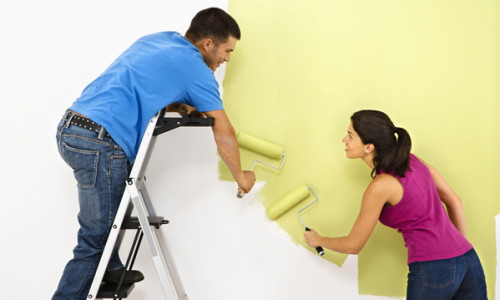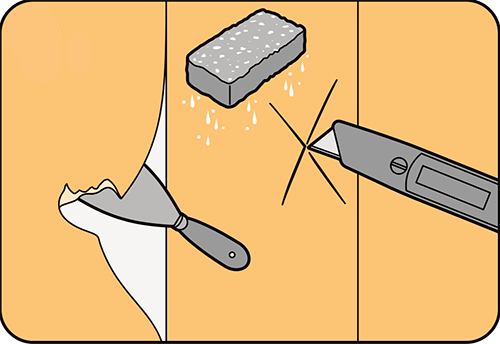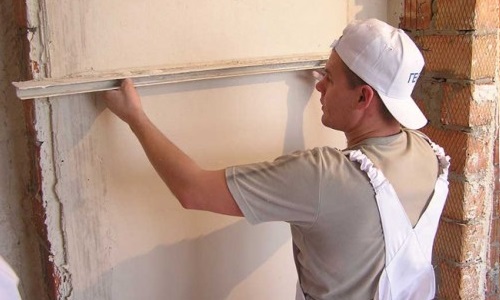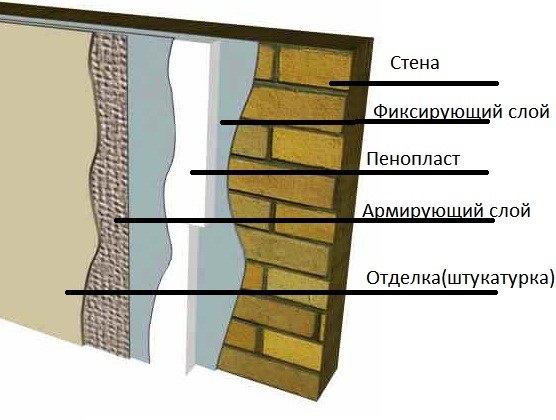Any professional finisher canconfirm that repairing the walls in a house or apartment is a large part of the work volume. In comparison to their importance in the external appearance of the home, the ceiling and floor clearly recede into the background. Any defects in the surface of the walls are much more noticeable. However, with the help of modern materials and technologies, as well as following certain rules, they can be repaired independently, without resorting to the help of hired specialists. This does not require great physical strength and special qualifications. All wall defects are very noticeable, so apartment renovation begins with wall restoration.
All wall defects are very noticeable, so apartment renovation begins with wall restoration.
Preparatory work: removal of old coatings
You can start repairing the wall right awayafter new communications have been laid or old ones have been repaired. First, it is necessary to remove old coatings that have become unusable. Wallpaper, especially those glued more than 10 years ago with the then types of glue, is removed quite easily. If there are areas where they are held tightly, they are removed with a wet rag and a scraper. It is also better to remove limescale deposits with a scraper and only then wash off the remains with a wet brush. With paint coating, everything is a little more complicated. If peeling areas are easy to remove with a scraper or a shoe knife, then the places where the old oil paint is held tightly will have to be melted with an industrial hair dryer before working with a scraper. Wall repair begins with removing the oldcoatings. Old plaster on the walls should be tapped with a wooden hammer or simply with your knuckles. If there are places where a dull sound is heard, then it will have to be removed, since repairs on an unreliable base are useless. If the peeling places fall off quite easily, then where it holds well, it will have to be knocked off with a hammer drill or a chisel with a hammer, if the areas are small enough. They will also have to be used to knock off the tile covering from the walls of the bathroom, toilet or kitchen. You can save the tiles intact only in those places where they were fixed with a simple cement mortar, and began to peel off the wall on their own. After all the old coatings have been removed, it is advisable to wash the surface from their remains and dust with a brush and water and you can begin the next stage of repair. Return to the table of contents</a>
Wall repair begins with removing the oldcoatings. Old plaster on the walls should be tapped with a wooden hammer or simply with your knuckles. If there are places where a dull sound is heard, then it will have to be removed, since repairs on an unreliable base are useless. If the peeling places fall off quite easily, then where it holds well, it will have to be knocked off with a hammer drill or a chisel with a hammer, if the areas are small enough. They will also have to be used to knock off the tile covering from the walls of the bathroom, toilet or kitchen. You can save the tiles intact only in those places where they were fixed with a simple cement mortar, and began to peel off the wall on their own. After all the old coatings have been removed, it is advisable to wash the surface from their remains and dust with a brush and water and you can begin the next stage of repair. Return to the table of contents</a>
Elimination of defects and surface leveling
 The walls are leveled with plaster or putty.The actual repair of the walls begins with identifying the presence of cracks on them. If such a crack goes across the entire surface of the wall of a multi-story building and especially becomes through, you need to invite specialists to repair it. If the crack is relatively small, you can easily repair it yourself. First of all, you will need to cut the edges of the crack diagonally using a narrow spatula. After that, it is thoroughly moistened with water using a foam sponge and a layer of putty is applied, pressing it hard into the crack so that it penetrates as deeply as possible. The putty should lie not only in the crack, but also on the adjacent surface of the wall. If there are protrusions on it, they are cut off with a hammer drill or chisel. After that, the surface is cleaned with an emery bar. You can level the wall both wet and dry. The first involves the use of aqueous solutions of plaster and putty, the second involves facing the walls with plasterboard. Plastering will cost significantly less, but will require more time for installation, taking into account the time required for drying. In addition, it should be used only when there is no need for additional insulation of the walls.
The walls are leveled with plaster or putty.The actual repair of the walls begins with identifying the presence of cracks on them. If such a crack goes across the entire surface of the wall of a multi-story building and especially becomes through, you need to invite specialists to repair it. If the crack is relatively small, you can easily repair it yourself. First of all, you will need to cut the edges of the crack diagonally using a narrow spatula. After that, it is thoroughly moistened with water using a foam sponge and a layer of putty is applied, pressing it hard into the crack so that it penetrates as deeply as possible. The putty should lie not only in the crack, but also on the adjacent surface of the wall. If there are protrusions on it, they are cut off with a hammer drill or chisel. After that, the surface is cleaned with an emery bar. You can level the wall both wet and dry. The first involves the use of aqueous solutions of plaster and putty, the second involves facing the walls with plasterboard. Plastering will cost significantly less, but will require more time for installation, taking into account the time required for drying. In addition, it should be used only when there is no need for additional insulation of the walls. Tools needed for leveling walls.The technology of applying the plaster coating involves installing beacons made of a metal profile, which are installed on the sides of the area. They are leveled with a plumb line and a nylon fishing line or cord is pulled between them. The cement mortar is applied starting from the floor level and the layer is raised upwards. All irregularities are smoothed out with a rule, which can be any flat board about 1.5 m long. As a finishing coat, you can apply gypsum putty to the cement plaster with a spatula. After that, you can glue the wallpaper or apply another decorative coating. It makes sense to attach drywall in two cases: if a layer of insulation is installed on the wall before this, if the repair time is very limited. In the first case, a frame made of a metal profile is attached to the wall, insulating material is placed in the gaps between the racks. The drywall coating is then attached to it. In the second case, you can do without a frame, you just need to lay waterproofing and then attach the plasterboard sheets with screws on plastic dowels. Return to the table of contents</a>
Tools needed for leveling walls.The technology of applying the plaster coating involves installing beacons made of a metal profile, which are installed on the sides of the area. They are leveled with a plumb line and a nylon fishing line or cord is pulled between them. The cement mortar is applied starting from the floor level and the layer is raised upwards. All irregularities are smoothed out with a rule, which can be any flat board about 1.5 m long. As a finishing coat, you can apply gypsum putty to the cement plaster with a spatula. After that, you can glue the wallpaper or apply another decorative coating. It makes sense to attach drywall in two cases: if a layer of insulation is installed on the wall before this, if the repair time is very limited. In the first case, a frame made of a metal profile is attached to the wall, insulating material is placed in the gaps between the racks. The drywall coating is then attached to it. In the second case, you can do without a frame, you just need to lay waterproofing and then attach the plasterboard sheets with screws on plastic dowels. Return to the table of contents</a>
Repair of the external surface of walls
 Scheme of repair of the external surface of the wall.As well as inside the house, crumbling plaster needs to be removed from the outside surface and cracks need to be sealed. The easiest way to repair the walls from the outside is to apply plaster. It is practically no different from carrying out such work from the inside, only it is advisable to add liquid glass to the cement mortar to prevent moisture penetration. If the wall needs insulation, then a frame made of a profile is mounted on it, and insulation is installed in its gaps. Only plastic siding is used as cladding instead of plasterboard. You can also install ready-made facade cassettes, clad the wall with natural or artificial stone. In general, it can be stated that to repair the surface of the walls both inside and outside the house, certain knowledge and skills in finishing work are needed. And if minor cosmetic repairs can be done on your own, then for more capital work it is advisable to involve specialists so that the result is of decent quality. Then the walls will please the eye of the owners and guests of the house, and not create problems for the residents.
Scheme of repair of the external surface of the wall.As well as inside the house, crumbling plaster needs to be removed from the outside surface and cracks need to be sealed. The easiest way to repair the walls from the outside is to apply plaster. It is practically no different from carrying out such work from the inside, only it is advisable to add liquid glass to the cement mortar to prevent moisture penetration. If the wall needs insulation, then a frame made of a profile is mounted on it, and insulation is installed in its gaps. Only plastic siding is used as cladding instead of plasterboard. You can also install ready-made facade cassettes, clad the wall with natural or artificial stone. In general, it can be stated that to repair the surface of the walls both inside and outside the house, certain knowledge and skills in finishing work are needed. And if minor cosmetic repairs can be done on your own, then for more capital work it is advisable to involve specialists so that the result is of decent quality. Then the walls will please the eye of the owners and guests of the house, and not create problems for the residents.


